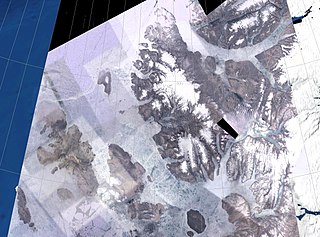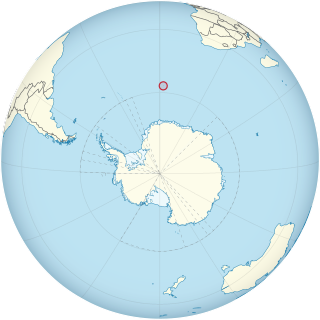
Telia Company AB is a Swedish multinational telecommunications company and mobile network operator present in Sweden, Finland, Norway, Denmark, Lithuania, Latvia and Estonia.

Jean-Baptiste Charles Bouvet de Lozier was a French sailor, explorer, and governor of the Mascarene Islands.

Bouvet was a pre-dreadnought battleship of the French Navy that was built in the 1890s. She was a member of a group of five broadly similar battleships, along with Charles Martel, Jauréguiberry, Carnot, and Masséna, which were ordered in response to the British Royal Sovereign class. Bouvet was the last vessel of the group to be built, and her design was based on that of Charles Martel. Like her half-sisters, she was armed with a main battery of two 305 mm (12 in) guns and two 274 mm (10.8 in) guns in individual turrets. She had a top speed of 18 knots, which made her one of the fastest battleships in the world at the time. Bouvet proved to be the most successful design of the five, and she was used as the basis for the subsequent Charlemagne class. Nevertheless, she suffered from design flaws that reduced her stability and contributed to her loss in 1915.
The extreme points of Norway include the coordinates that are farther north, south, east or west than any other location in Norway; and the highest and the lowest altitudes in the country. The northernmost point is Rossøya on Svalbard, the southernmost is Pysen in Mandal, the easternmost is Kræmerpynten on Svalbard, and the westernmost is Hoybergodden on Jan Mayen. The highest peak is Galdhøpiggen, standing at 2,469 m (8,100 ft) above mean sea level, while the lowest elevation is sea level at the coast.

The Sverdrup Islands is an archipelago of the northern Queen Elizabeth Islands, in Nunavut, Canada. The islands are situated in the Arctic Ocean, west of Ellesmere Island from 77° to 81° North and 85° to 106° West.

Cape Circoncision is a peninsula on the north-western edge of subantarctic Bouvet Island. The small peninsula was sighted by the French naval exploration that was led by Jean-Baptiste Charles Bouvet de Lozier on 1 January 1739, the Feast of the Circumcision day -- thus the name. The cape provided the location for the base-camp of the 1928-29 Norwegian expedition.
.bv is the Internet country code top-level domain (ccTLD) reserved for the uninhabited Norwegian dependent territory of Bouvet Island. The domain name registry and sponsor is Norid, but .bv is not open for registration. .bv was designated on 21 August 1997 and was placed under the .no registry Norid. Norwegian policy states that .no is sufficient for those institutions connected to Bouvet Island, and therefore the domain is not open to registration. It is Norwegian policy not to commercialize domain resources, so there are no plans to sell .bv. Should the domain later come into use, it will be under the regulation of the Norwegian Post and Telecommunications Authority and follow the same policy as .no.
.sj is the Internet country code top-level domain (ccTLD) reserved for the designation Svalbard and Jan Mayen. The domain name registry is Norid, but .sj is not open for registration. The issuing of the domain was based on the ISO 3166 designation of Svalbard and Jan Mayen, which consists of two separately administrated integrated territories of Norway: the Arctic archipelago Svalbard and the nearly uninhabited volcanic island Jan Mayen. .sj was designated on 21 August 1997, at the same time as Bouvet Island was allocated .bv. Both were placed under the .no registry Norid, which is also the sponsor. Norwegian policy states that .no is sufficient for those institutions connected to both Svalbard and Jan Mayen, and therefore the domain is not open to registration. It is Norwegian policy not to commercialize domain resources, so there are no plans to sell .sj. Should the domain later come into use, it will be under regulation of the Norwegian Post and Telecommunications Authority and follow the same policy as .no. There are two second-level domains reserved for the two areas: svalbard.no and jan-mayen.no, but other web addresses are also used.
Bouvet can have the following meanings:

The Norwegian Polar Institute is Norway's central governmental institution for scientific research, mapping and environmental monitoring in the Arctic and the Antarctic. The NPI is a directorate under Norway's Ministry of Climate and Environment. The institute advises Norwegian authorities on matters concerning polar environmental management and is the official environmental management body for Norwegian activities in Antarctica.

Joachim Bouvet was a French Jesuit who worked in China, and the leading member of the Figurist movement.

UTC+01:00 is an identifier for a time offset from UTC of +01:00. In ISO 8601, the associated time would be written as 2019-02-07T23:28:34+01:00. This time is used in:

Bouvet Island is a Norwegian uninhabited protected nature reserve. As a subantarctic volcanic island, it is situated in the South Atlantic Ocean at the southern end of the Mid-Atlantic Ridge, making it the world's most remote island. It is not part of the southern region covered by the Antarctic Treaty System.

Cape Valdivia is the northernmost point on Bouvet Island in the South Atlantic Ocean. The subantarctic Bouvet Island is administered by Norway.

Norway is commonly divided into five major geographical regions (landsdeler). These regions are purely geographical, and have no administrative purpose. However, in 2017 the government decided to abolish the current counties of Norway (fylker) and to replace them with fewer, larger administrative regions (regioner). The first of these new areas came into existence on 1 January 2018, when Nord-Trøndelag and Sør-Trøndelag merged to form Trøndelag.
Norway's elongated shape, its numerous internal geographical barriers, and the often widely dispersed and separated settlements are all factors that have strongly influenced the structure of the country's administrative subdivisions. This structure has varied over time and is subject to continuous review. In 2017 the government decided to abolish some of the counties and to merge them with other counties to form larger ones, reducing the number of counties from 19 to 11, which was implemented on 1 January 2020.
The following details notable events from the year 1826 in Norway. Norway is a Nordic unitary constitutional monarchy whose territory comprises the western portion of the Scandinavian Peninsula, Jan Mayen, the Arctic archipelago of Svalbard and the subantarctic Bouvet Island. Key domestic issues include maintaining the country's extensive social safety net with an aging population, and preserving economic competitiveness. See also: Norway

Norway has three dependent territories, all uninhabited and located in the Southern Hemisphere. Bouvet Island (Bouvetøya) is a sub-Antarctic island in the South Atlantic Ocean. Queen Maud Land is a sector of Antarctica which spans between the 20th meridian west and the 45th meridian east. Peter I Island is a volcanic island located 450 kilometres (280 mi) off the coast of Ellsworth Land of continental Antarctica. Svalbard is not formally considered to be a dependency. While the Svalbard Treaty regulates some aspects of that Arctic territory, one article acknowledges that these islands are part of Norway. Similarly, Jan Mayen is recognized as an integral part of the nation. Both are, however, unincorporated areas.
This article is a comparison of the Nordic countries.











